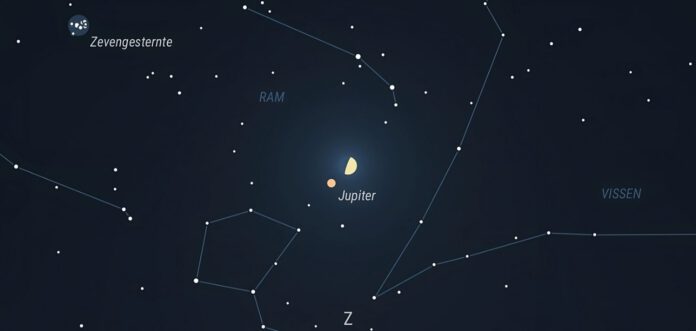
Possessing night sky clarity? Gaze upwards this evening and you will detect an illustrious ‘star’. This prominent celestial sight is none other than Jupiter, the largest planet in our solar system. This gas giant appeared right beside the Earth’s natural satellite in the night sky.
Realistically though, the gap between the moon and Jupiter spans over 700 million kilometers. Despite this vast distance, both these celestial bodies appear juxtaposed due to the moon’s position, situated between Earth and Jupiter. This celestial alignment is notably observable in the depiction below. Alongside Jupiter and the moon, one might also spot Uranus but would need the help of a solid pair of binoculars or, preferably, a telescope.
The Role of Jupiter and the Earth’s Moon
Jupiter, reflecting a magnitude of -2.5, wears the crown for the brightest ‘star’ in the evening sky. Just for comparison, Sirius, the brightest actual star, exhibits a magnitude of -1.33. Since Earth outpaces Jupiter in its orbit around the sun, visibility of this gas giant will reduce in the upcoming months to eventually escape our sight. Expect the grand reappearance of Jupiter around the close of the current year. Admire Jupiter through a telescope and be privy to its cloud bands and the four largest moons: Io, Callisto, Ganymede, and Europa.
Observational Opportunities
The moon catches partial illumination, making it the perfect time to examine our celestial neighbor through a telescope or binoculars. Experts on domains such as Waarnemen.com report detailed perceptions like how the sun edges over the boundary between the dark and light portions, casting long shadows from mountains and crater ridges, and thereby creating an enticing depth effect.
Captured a stunning image of Jupiter cohabiting the sky with the moon? Feel free to share your stargazing moments below this article or up on platform X (the once referred to as Twitter) – already home to the first shared images.
Celestial Snapshots
Delighted stargazers have already begun sharing their observations on social media, showcasing the dazzling visibility of Jupiter and the Earth’s moon. One tweet with the accompanying image reads, ” Hurray, it’s clear! Take a look if you can find the moon. See that bright spot to the lower left of the moon? That’s Jupiter! 🌌🌓”.
While another excited observer shared, “Look at that, the jovial duo. That bright spot to the lower left of the #moon tonight (Thurs Jan 18) is not a #star but the planet #Jupiter! Take a look if it’s clear! “.











